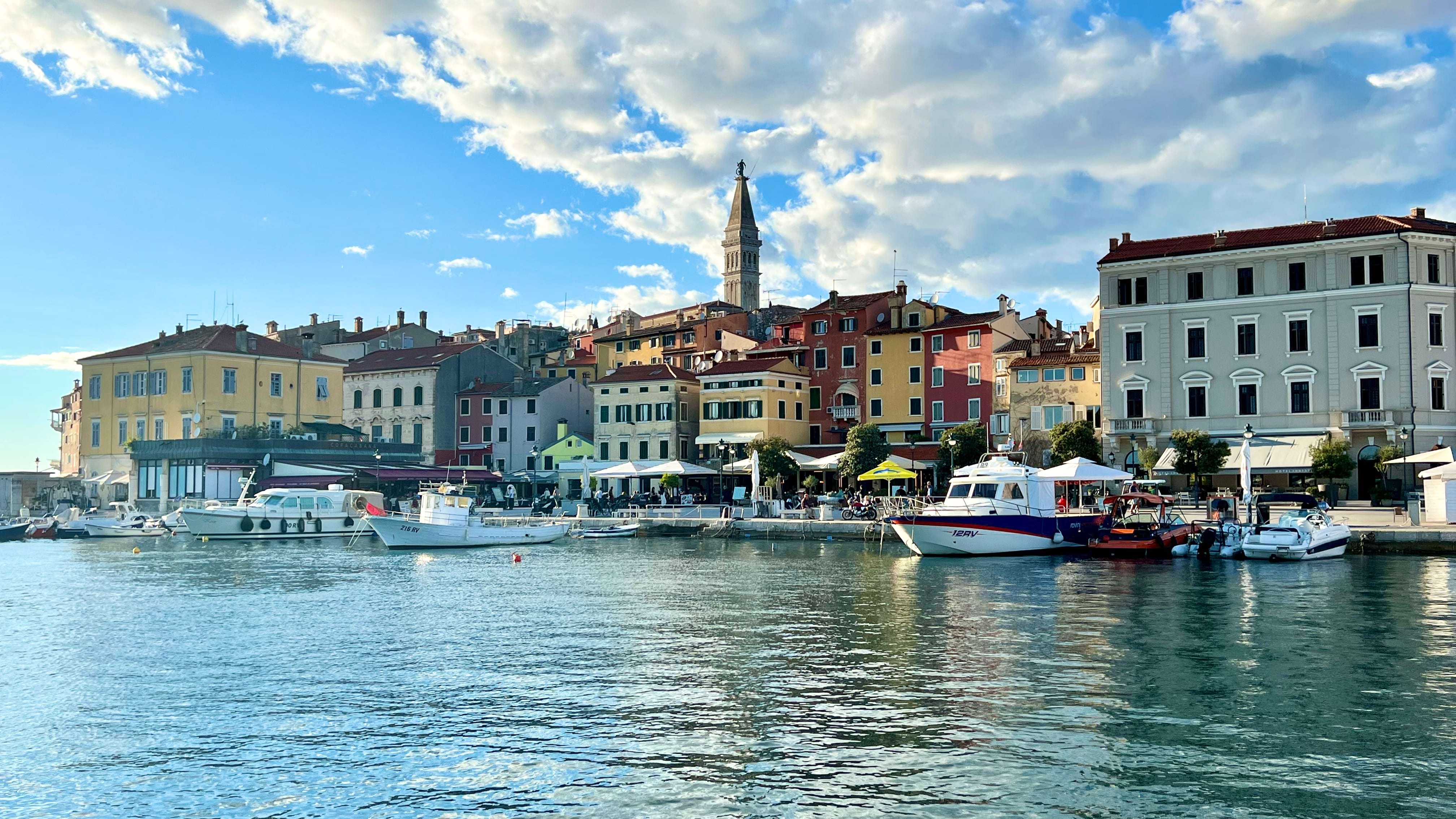
Table of Contents
Our discovery of Rovinj, the seaside town known as “Little Venice” in Croatia’s Istria region, began with a stay at Villa Dobravac, a bucolic family-run B&B and winery. Later we walked through the Old Town’s Venetian streets, little changed in 700 years.
Our visit ended with a fungus-sprinkled, grappa-fueled meal at Scuba, a most tolerant restaurant.
Date of Visit: September 20-22, 2022
Forty-five minutes had passed since our record-breaking one-hour dash around the medieval hilltop town of Motovun. As the sun set, we arrived at Villa Dobravac, a family-run B&B with a winery on the outskirts of Rovinj’s Old Town.
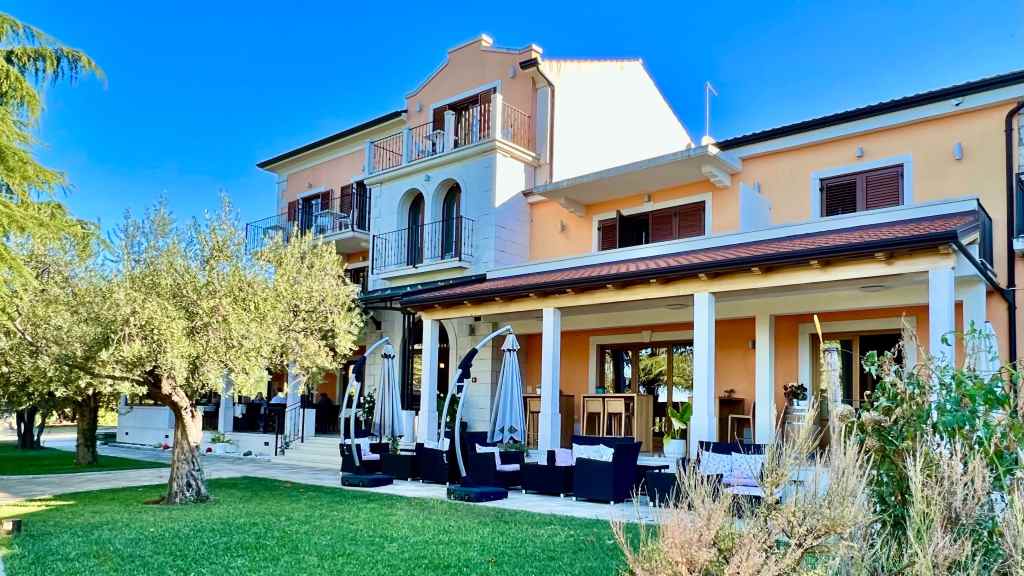
Its cheerful saffron-colored facade was a welcome sight; its architecture, a blend of Farmhouse, meets Art Deco with a nod to Ancient Rome. Yet somehow, it seemed distinctly Istrian.
Where We Stayed
In the surrounding hills of the Dobravac wine estate, the family’s vineyards produce Malvasia, Teran, and Muscat wines. Conveniently, off the inn’s foyer, there’s a tasting room to sample these crisp and flavorful Istrian red and white wines.
The location, a 15-minute walk from the Old Town, was a pleasant surprise. Behind a rangy pine tree, there’s a bird’s eye view of the old Venetian town of Rovinj jutting out into the deep blue Adriatic Sea. In the distance, a prominent bell tower next to the Church of St. Euphemia rises nearly 200 ft over the red-roofed town.
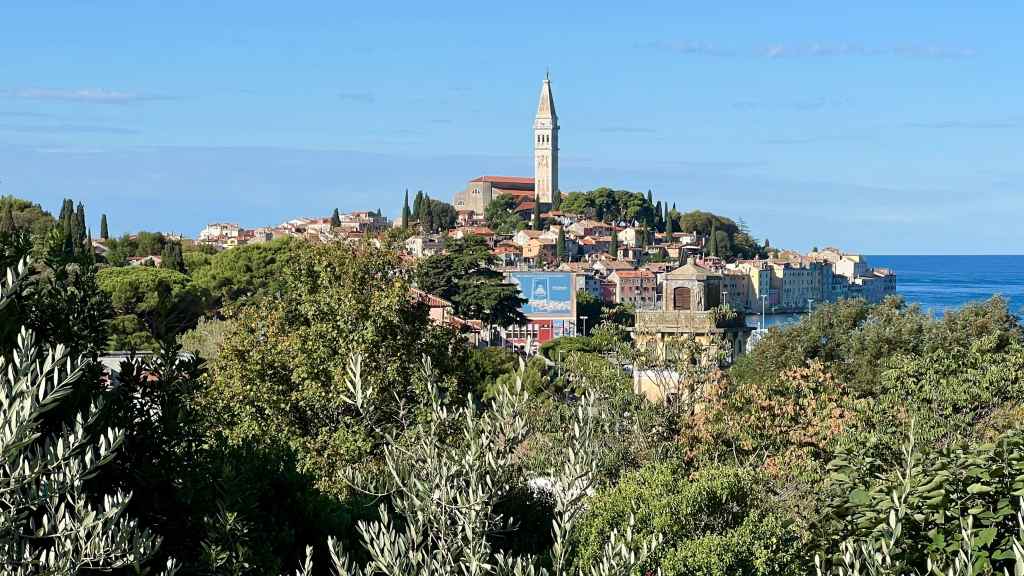
It’s easy to become lost in time gazing at history in real-time. I imagined Venetian fishing boats in the harbor and laborers hard at work building ships.
But then, a large ad painted on the side of a distant building reminded me that I was standing here several hundred years after the Republic of Venice’s 500-year rule.
Before checking into the inn, Chris and I discussed dinner plans with our hired driver. Frane was a fun traveling companion, and we wanted to treat him to dinner. After four days on the road together, we enjoyed his stories about Croatia and dry sense of humor.
The Elusive Truffle—Not!
Earlier in the day, I had expressed disappointment about not having time to go truffle hunting in the Istrian forest.
“Do you think you can find the truffle in one hour?” Frane asked.
“It takes five days to find the truffle, and you go there, and the dogs find the truffle in one hour. It is not real.”
We laughed at the absurdity of it all and decided to hunt for a truffle restaurant in Motovun instead (see Istria: Racing Through Motovun).
Since none of us had researched restaurants in Rovinj, we made plans to meet for dinner in the Old Town the following evening. We’d check out the best restaurants in the meantime.
Americans in Rovinj
Behind the reception desk, Natalina Dobravac was talking to a 30-something German guest dressed in business attire. They both looked up when we walked in with our luggage.
“You are from the U.S.? The German asked incredulously.
“How did you find this place?”
I was taken aback. We’re not often made to feel exotic when we travel to Europe; at least, we weren’t before the pandemic. I assumed Croatia would be overrun with my countrymen and women, and we wouldn’t so much as raise an eyebrow unless, of course, we did something gauche. I hoped it was just our accents that gave us away this time.
The German peppered us with questions as we checked in. I wondered if this “scarcity of Americans” was because fewer foreign cruise ships stopped in Rovinj (compared to Dubrovnik, Split, and Hvar) or if it was simply the pandemic that had made us scarce in Europe until recently.
Natalina grabbed our heavy suitcases and headed up the stairs to the Romeo and Juliet room (#103) that would be ours for two nights. She firmly refused Chris’ protests for us to carry our bags.
I smiled to myself because I had noticed the words “Women-Power” emblazoned on the t-shirt under her jean jacket.
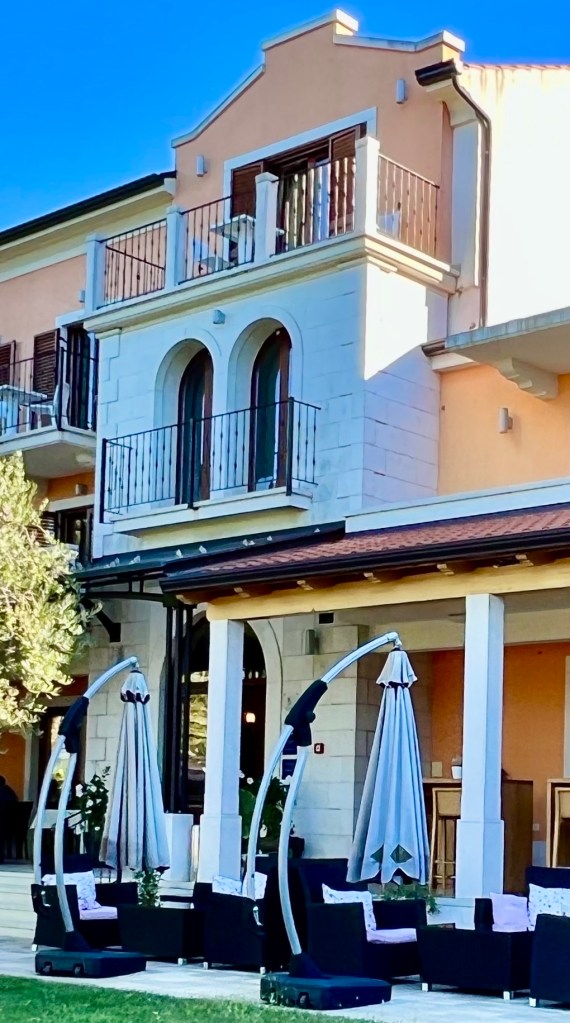
Restaurant Tips From a Local
Natalina recommended seven restaurants in the Old Town for the following evening. One was the top-rated Puntulina Restaurant & Wine Bar (“La Puntulina”), where diners sip cocktails and dine on rocky outcrops at the water’s edge.
She warned us that La Puntulina was always booked weeks out and doubted we could get into these popular restaurants on such short notice. As it turned out, she was right.
* Restaurant Owned by the Pellizzer family.
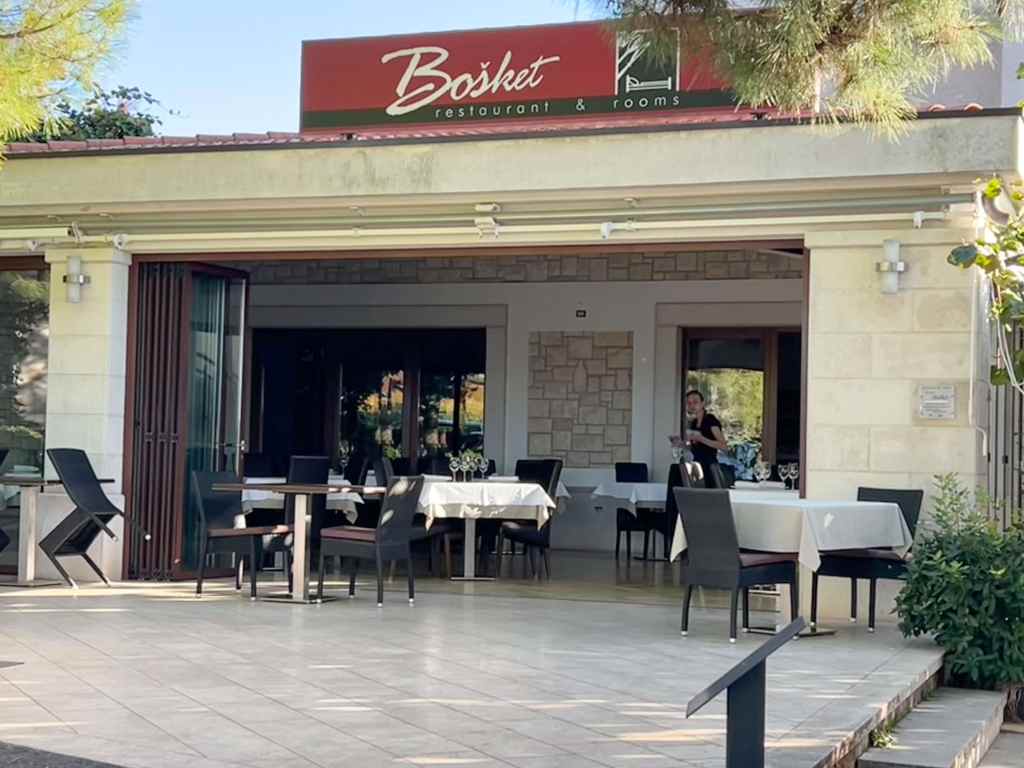
That night Chris and I ate dinner across the road from Villa Dobravac at Bošket Restaurant & Rooms.
It’s a stone’s throw from Rovinj’s working harbor, and I could smell the sea in the night air even if I couldn’t see it in the dark. The family-run restaurant was brightly lit and full of jocular diners.
Honey-laced Grappa Discovery
Choosing from Bošket’s Mediterranean and Croatian seafood and vegetable entrees took time as everything looked good.
I finally settled on calamari fritti to complement my glass of Malvazia Istarska wine. Chris picked pasta with the day’s local catch, and we split a tasty citrus salad. He ordered a glass of Istria’s Teran.
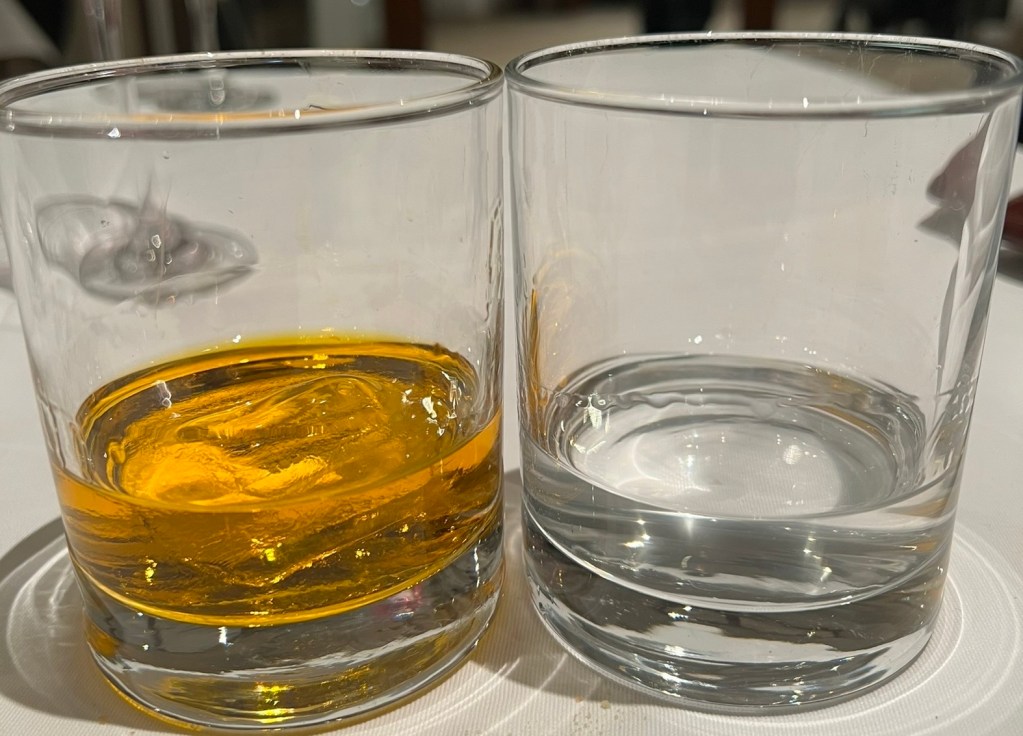
Our waitress surprised us with grappa at the end of the meal. She placed two glasses of honey-flavored and straight-up pomace brandies on the table. We had never tasted Grappa before. I was not a brandy fan and figured the honey-laced brandy would go down easier.
Chris opted for the unadulterated version because our waitress had given him the impression that it was the manly choice. However, he regretted his decision after a sip of my delicious drink.
Ultimately, it didn’t matter because they got us to our happy places that night.
I’ve decided that brandy isn’t so bad, especially when bees are involved. I did worry that my sip of Chris’ stiff drink (he insisted) might put hair on my chin, but so far, so good.
Breakfast at the Villa
The following day, we were surprised to find our appetites again. We tucked into a hearty breakfast with a rich brew of coffee in Villa Dobravac’s cozy dining room overlooking the inn’s bucolic grounds.
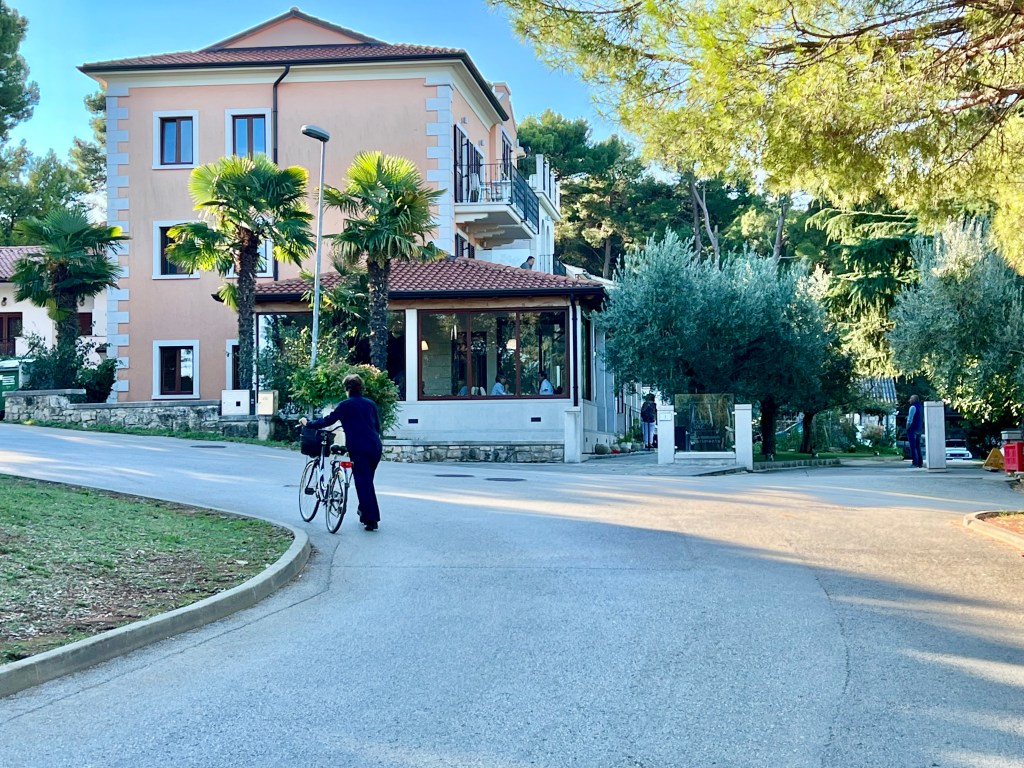
The plan was to spend the day exploring Pula, Istria’s largest city, and then wine-tasting in Vodnjan before returning to explore Rovinj. I’ll stick with our impressions of Rovinj for this post, but my next post will be dedicated to our winery visit and Pula.
“Old Town" Rovinj
Later that evening, we walked to the Old Town of Rovinj, considered by many to be the most romantic town in Croatia. It’s also arguably the most Italian.
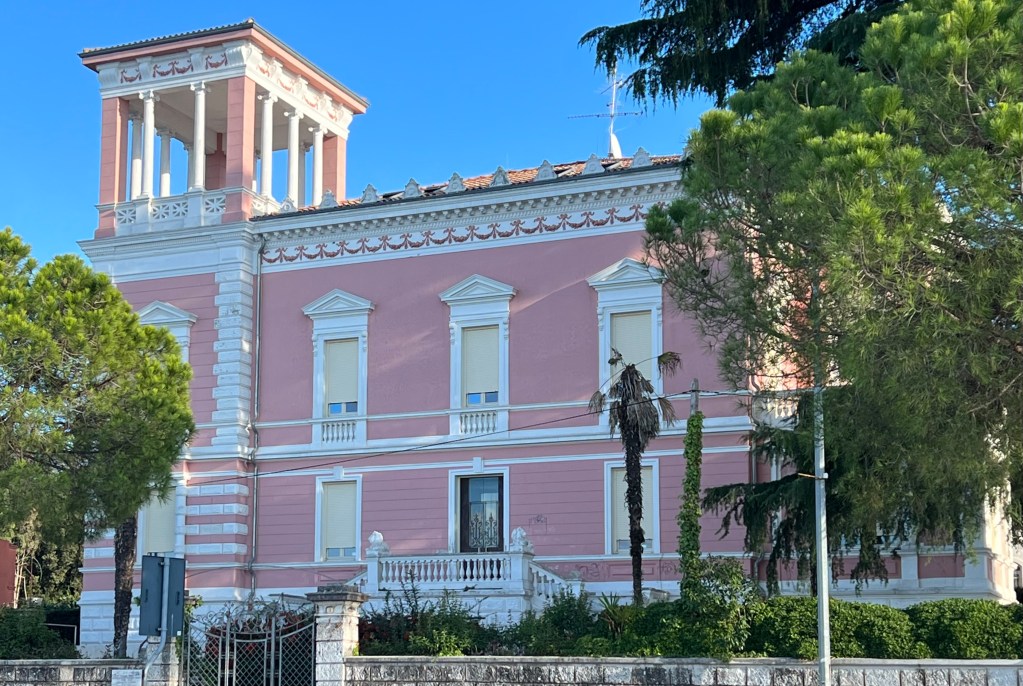
We walked past fishing boats in the harbor and large pastel mansions, starkly contrasting with the humble homes that fishermen lived in for centuries within the Old Town proper.
How It Was...
Old Town Rovinj’s weathered Venetian buildings rise a few feet from the water’s edge like an uneven fortress wall. In fact, before they became homes, they were the city’s defensive walls, protecting the town from pirates.
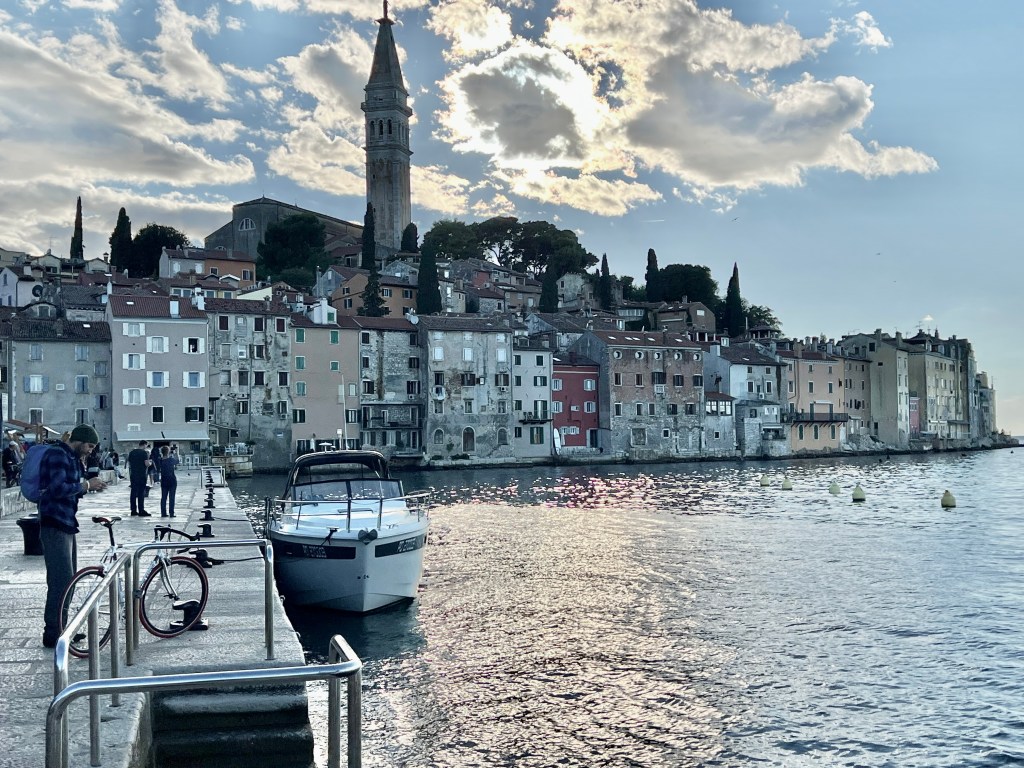
In years past, fishermen would tie their boats a few feet from their front doors and bring their fresh catch inside for their fishwives to cook.
“Honey, I’m home. How about Sheepshead bream tonight? The Sea Devils weren’t biting today.”
Sorry, my imagination got away from me for a moment.
How It Is...
The shiny, uneven cobblestone streets led us deep into the shadows of the old Venetian buildings.
This pedestrian zone was an unexpected hive of activity. Boutiques, galleries, souvenir shops, and outdoor cafes beckoned with colorful displays and menu boards.
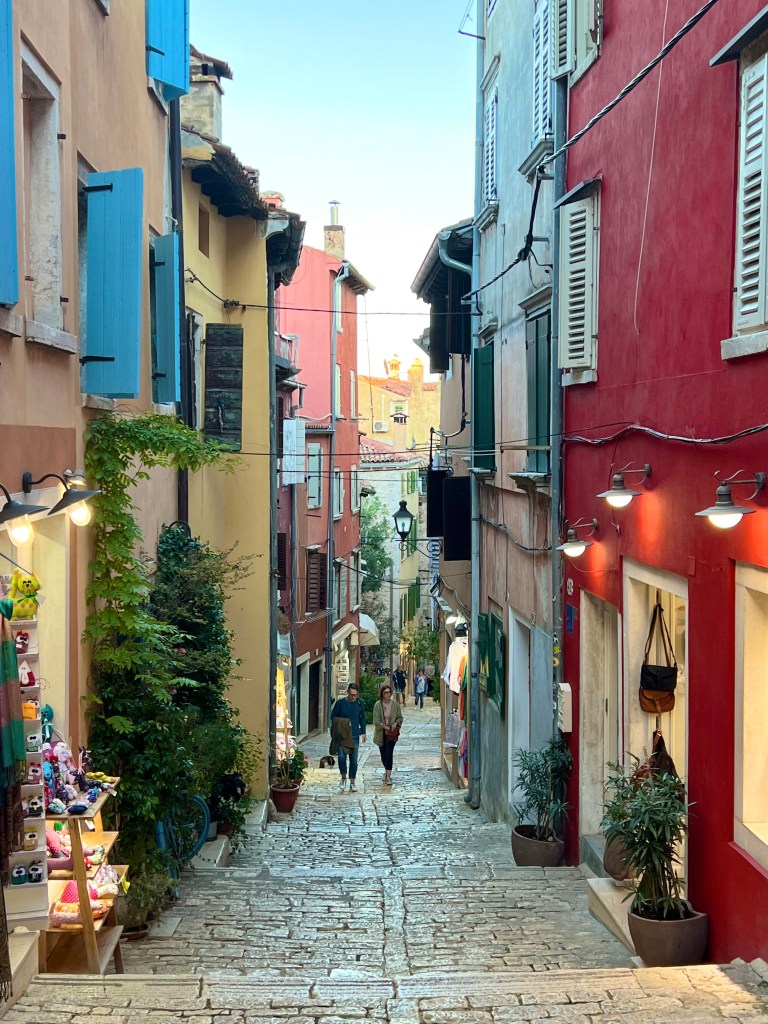
In Search Of a Restaurant
Chris had contacted the restaurants Natalina recommended, but as she predicted, all were booked. So he made an online reservation at a restaurant a few doors down from Scuba, close to Tito Square and the long pier.
I won’t mention the restaurant because it wasn’t on the list, and, in the end, we didn’t eat there.
Our rationale was that Scuba and La Puntulina were nearby. We hoped the proximity to Natalina’s recommendations bode well.
Frane would meet us in about an hour. Until then, we would walk the serpentine streets of Rovinj up to the Church of St. Euphemia and its bell tower.
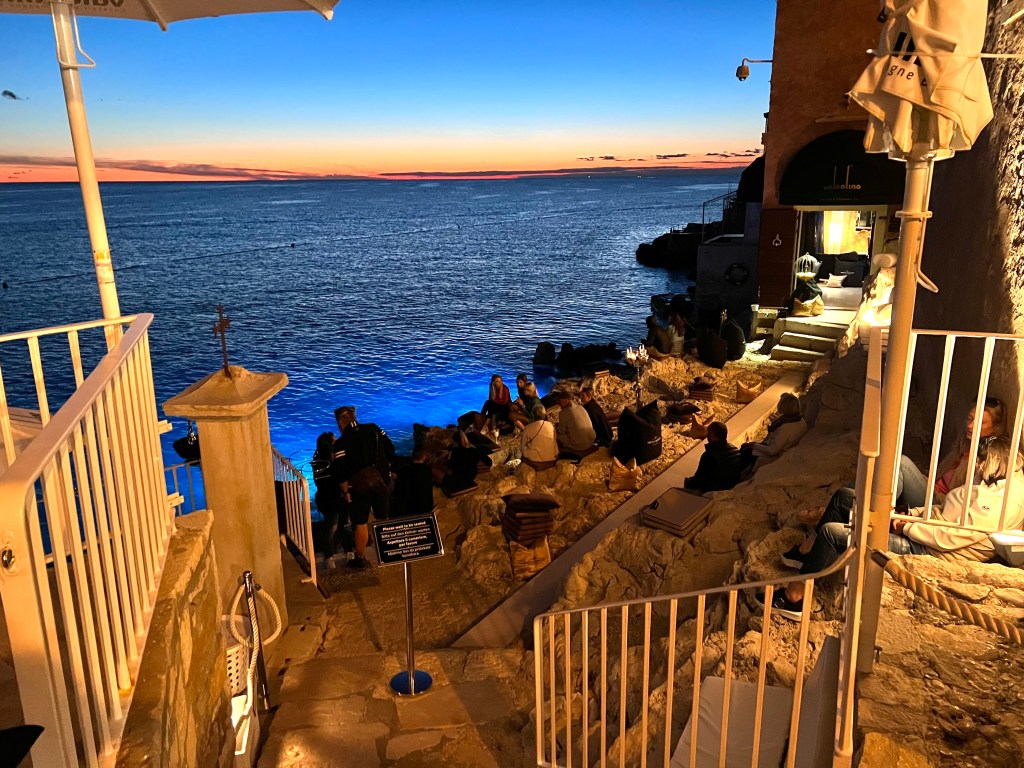
The Raw Beauty of Rovinj
This is when we fell in love with the raw, native beauty of Rovinj. We passed under the Balbi Arch that replaced one of the original seven stone gateways to medieval Rovinj in the late 1670s.
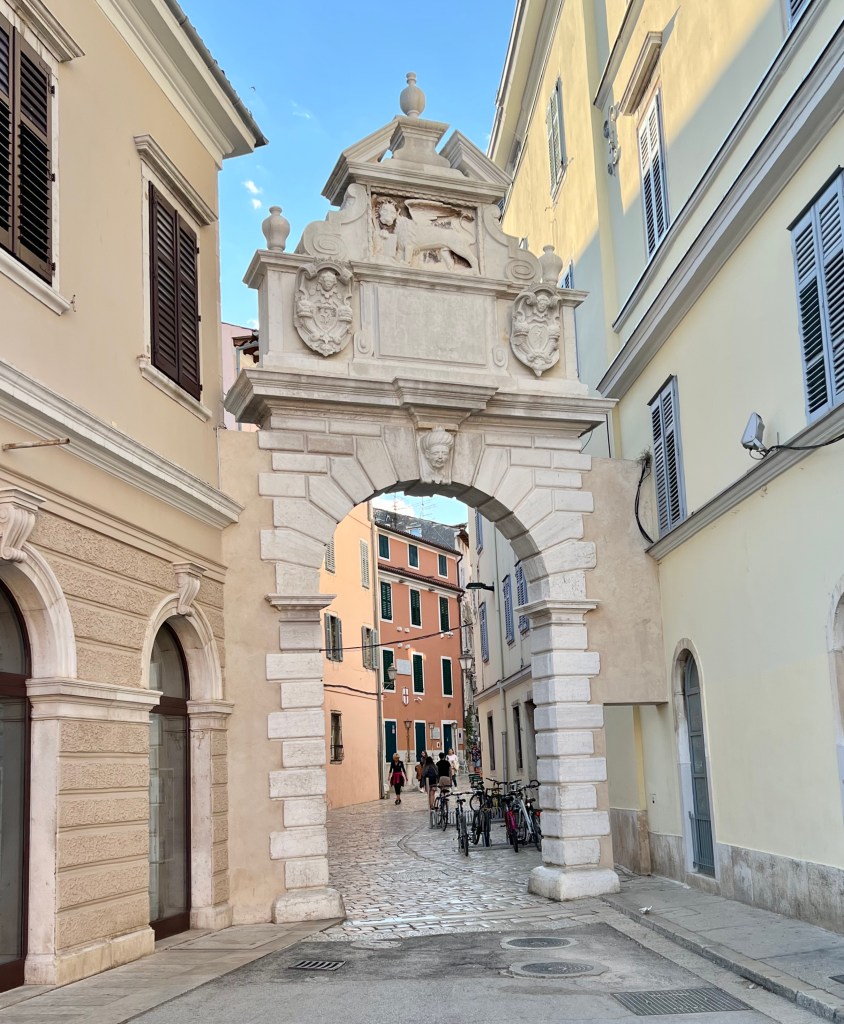
Balbi Arch is decorated in the Baroque fashion of its era with St. Mark’s winged lion and carved heads of a Turk and a Venetian on each side.
About 100 years later, in the 18th century, the Italian Balbi family crests were added as an ode to the city’s then-Prefect. Though the arch memorializes his name, I doubt anyone can tell us much about him today.
Where The Locals Live
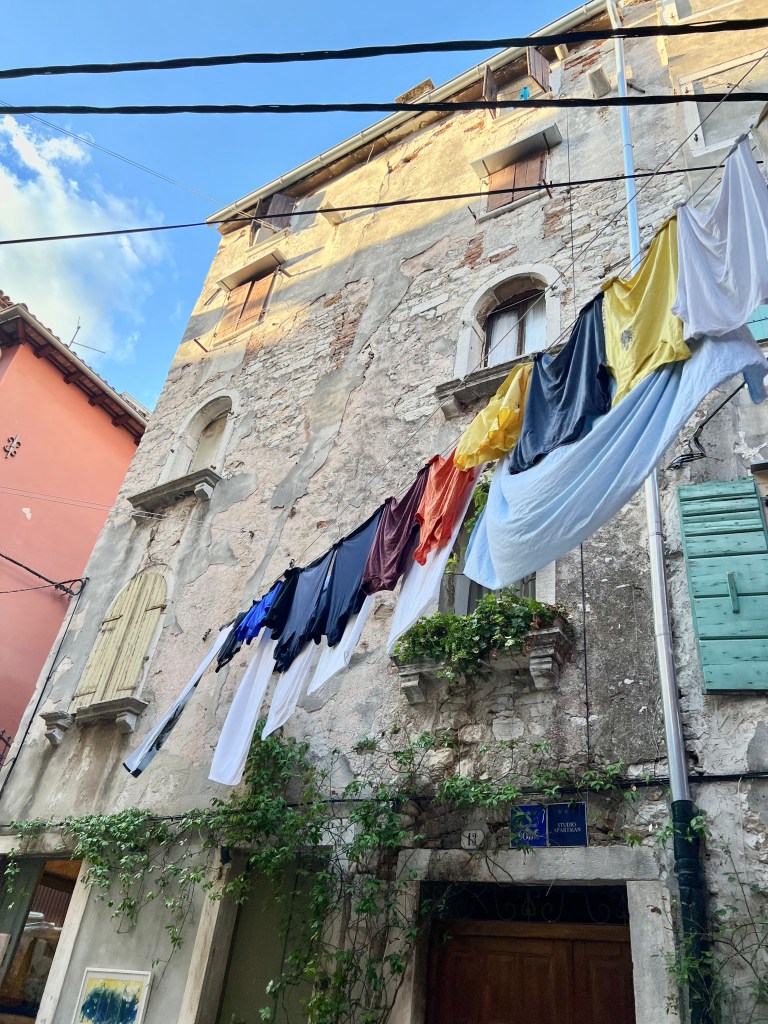
The Balbi Arch led us to a narrow street where we wound up the hill to a labyrinth of smaller residential streets.
We walked under clotheslines strung high between apartments. Shirts, sheets, and unmentionables flapped in the breeze. So this is where the locals live, almost as they have for hundreds of years, except for the cable wires and a few air conditioners under windows.
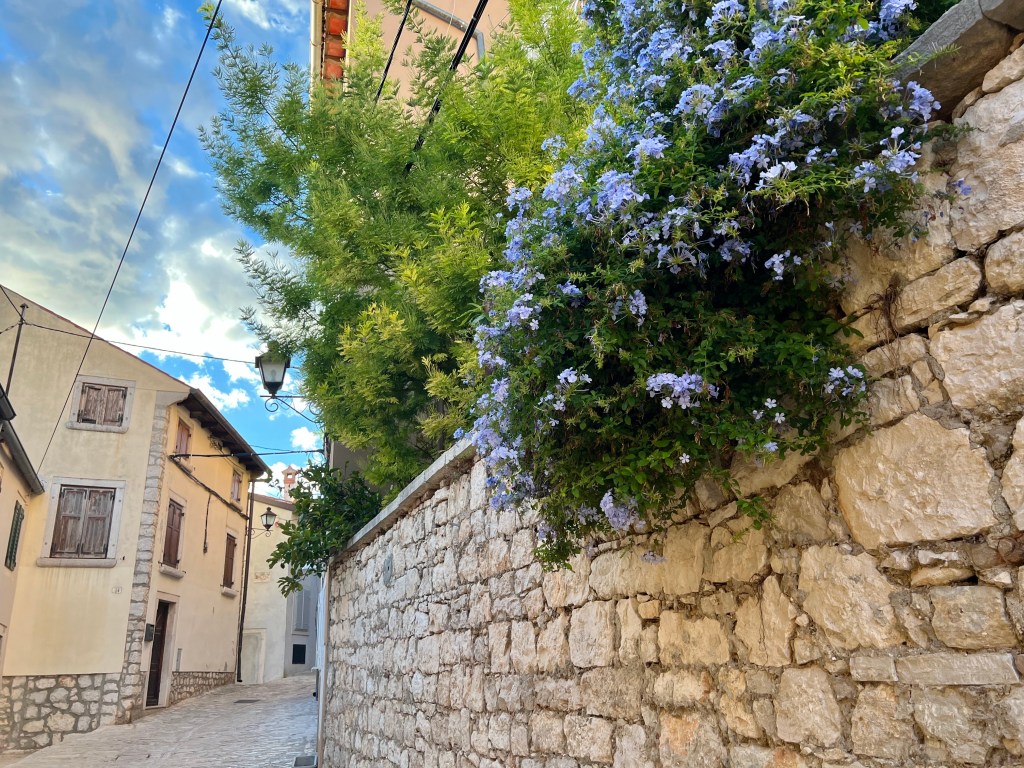
Plants hung from windows in the few places where the sun’s rays filtered through the dense housing and narrow streets. We passed a rough-hewn limestone wall trailing blue forget-me-nots. And suddenly, the church appeared at the top of the hill.
St Euphemia Church
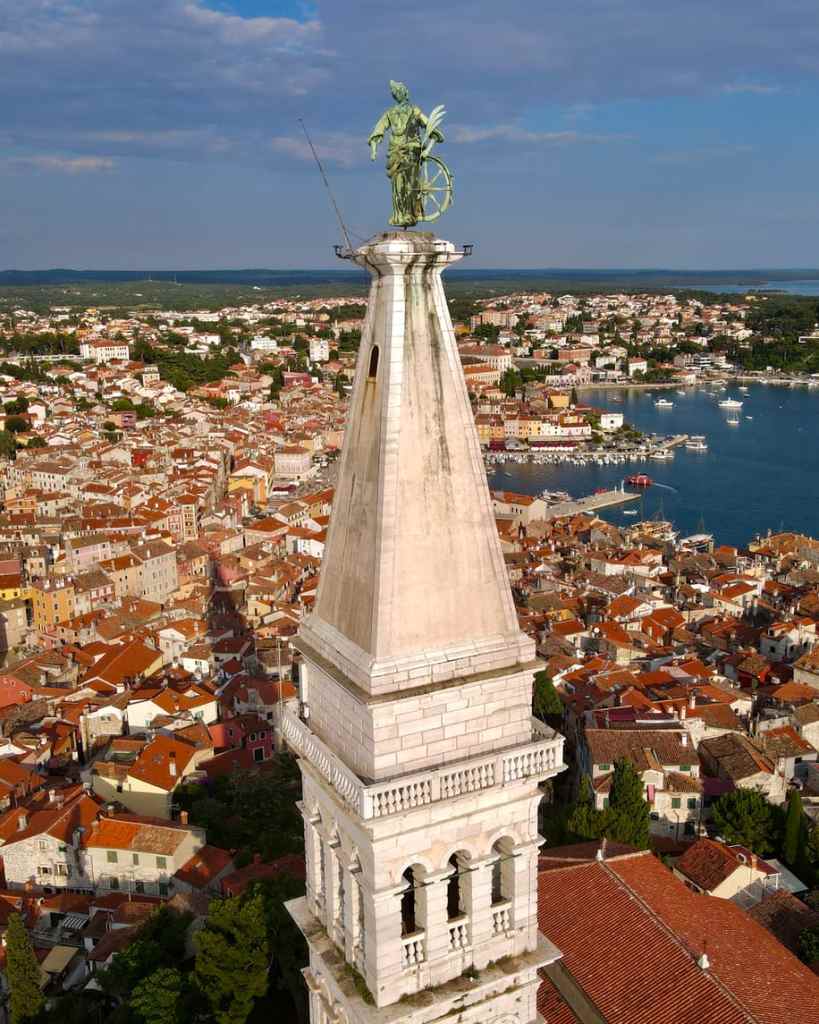
I had read in Rick Steve’s Croatia & Slovenia guidebook that Rovinj’s bell tower was modeled after the campanile or bell tower of St Mark’s Basilica in Venice. There’s a difference, though. A weathervane in the likeness of the archangel Gabriel caps the Venetian spire.
At the top of Rovinj’s bell tower is a weathervane representing the church’s namesake, the patron Saint Euphemia.
Patron Saint Euphemia
As with many Catholic saints, Euphemia met a tragic ending. She was a 15-year-old Christian girl tortured by the Romans who punished those who didn’t believe in their pagan gods. Info Rovinj wrote about the 3rd Century legend here.
Suffice it to say that Emperor Diocletian was a nasty, intolerant sort when it came to the subject of religious freedom. There will be more to say about him when we get to Split and Dubrovnik toward the end of our Balkan trip.
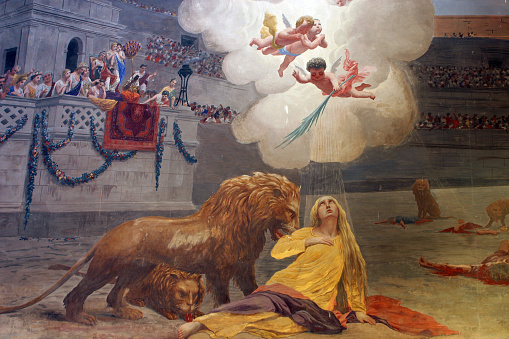
Saint Euphemia’s relics are encased in a Roman sarcophagus from the sixth century inside the Church. Late Gothic statues and Christian paintings from the 16th and 17th centuries adorn the Church, which was dedicated to St. George before Saint Euphemia became the patron saint of Rovinj.
Skating On Cobblestones
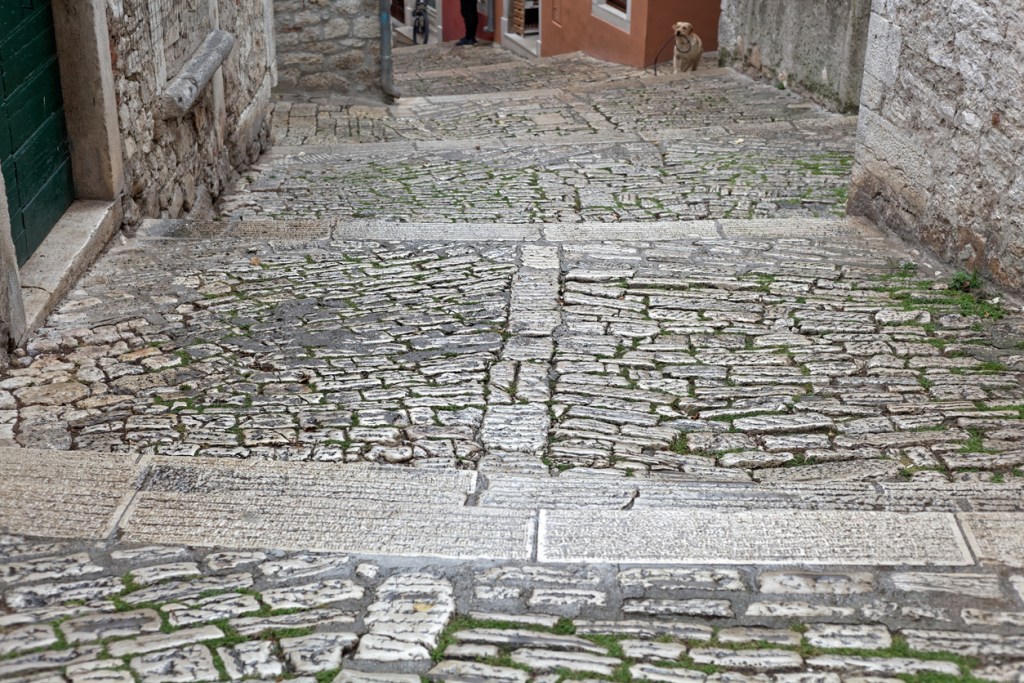
Incredibly, I had made it up the hill in my leather-soled mules. High heels would have been the only thing worse on these slick lime-stone cobbles.
These slip-on wedge shoes were my compromise for our night out, but sneakers would have been safer.
On the way down, my mules turned into ice skates, and Chris had to hold me tight.
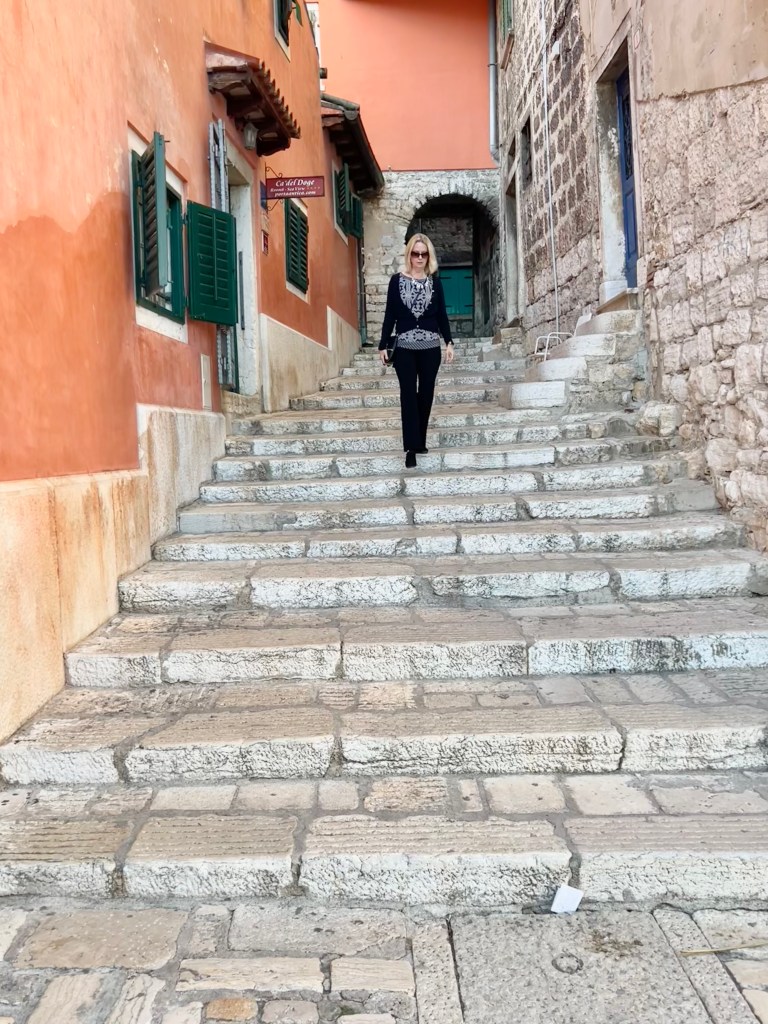
Buying Gifts at Aura
On trendy Grisia street, we passed art galleries and my new favorite gift shop, Aura, as we picked our way over the cobblestones. Earlier that day, our private guide in Pula had included the store there in her tour. Known for their traditional products made with wild herbs and fruits, there are 10 or so scattered around Croatia. They all look a little different on the outside.
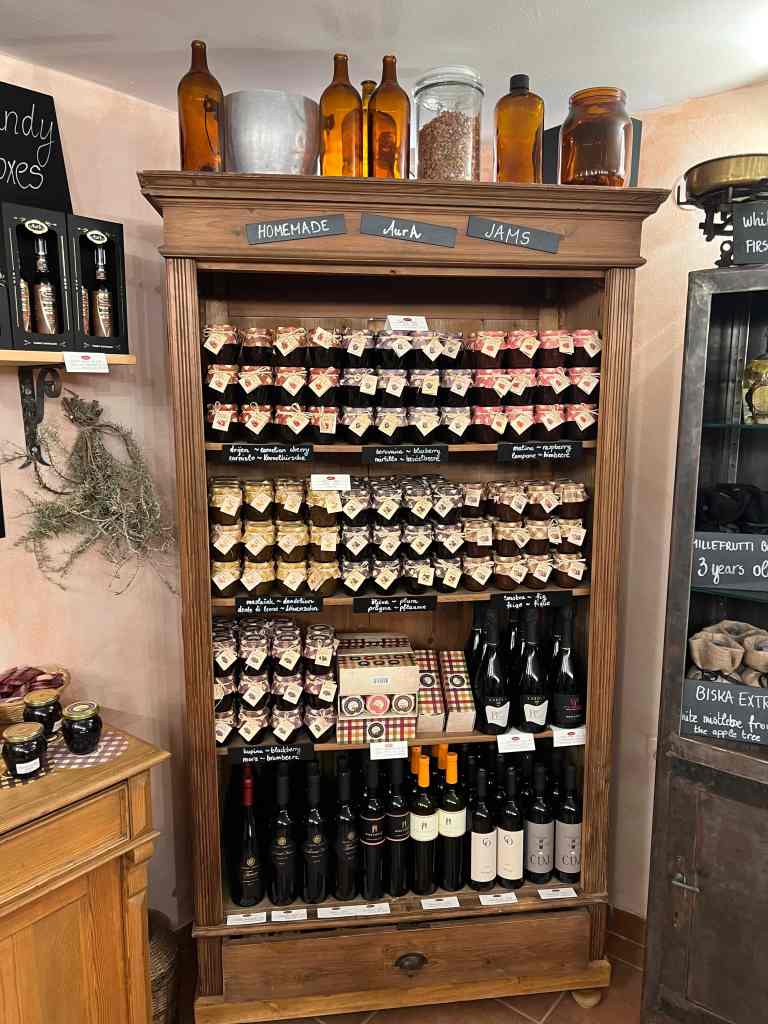
The Rovinj store beckoned with large wicker baskets and Istrian urns outside the open door, its shelves of liquors, jams, and Croatian gifts visible in the warm glow of the interior. Since we still had time before our dinner reservation, we bought truffles, jams, and scented soaps to bring home for gifts.
The Harbor Near Tito Square
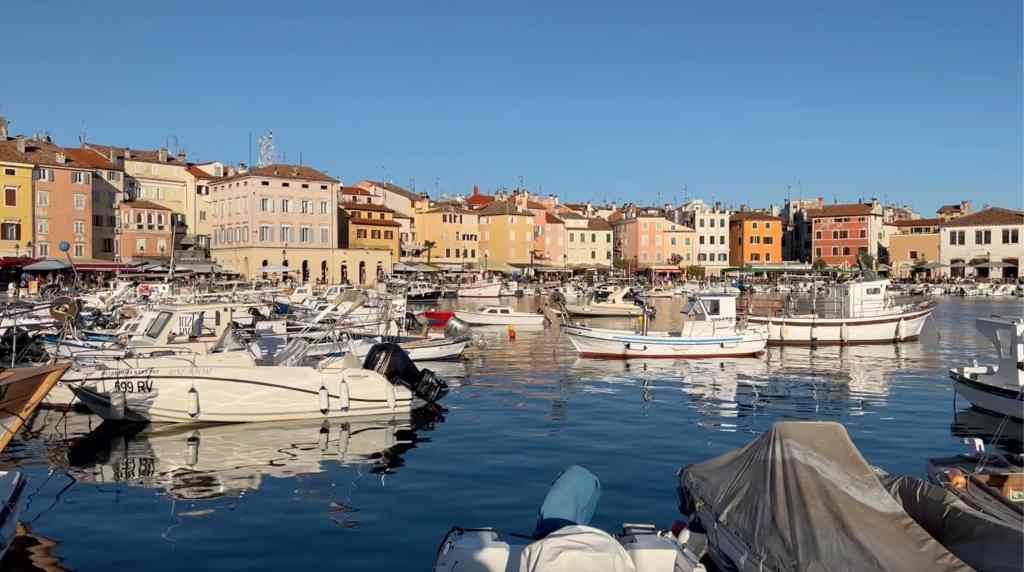
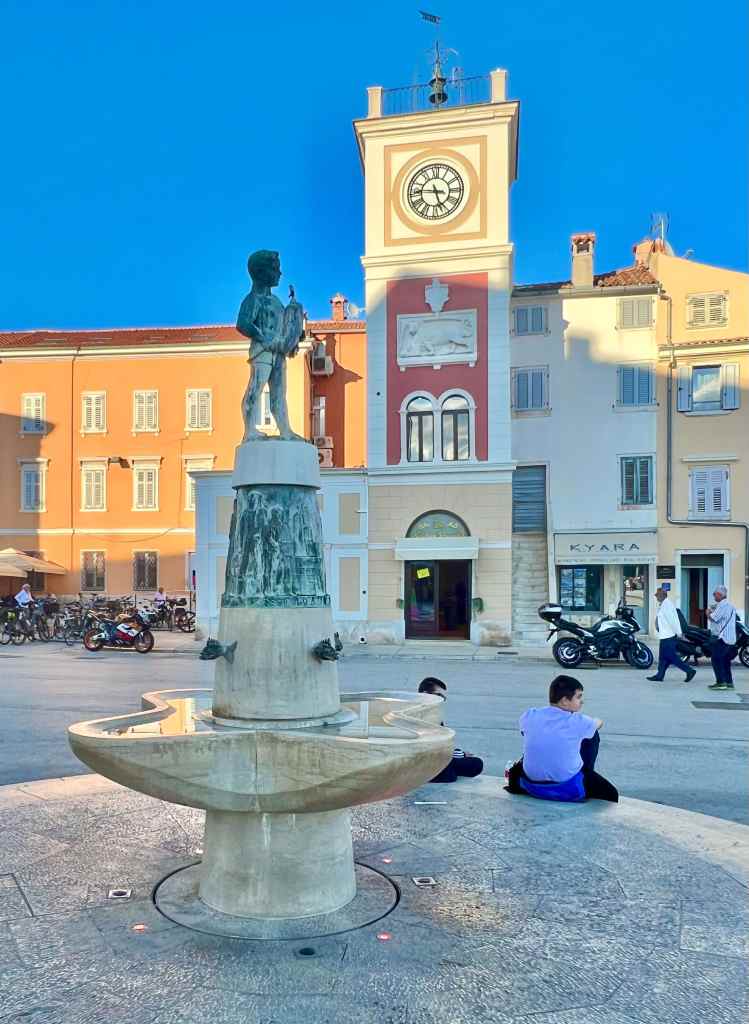
Eventually, we ended up at Marshal Tito Square near the waterfront restaurants.
During the day, sightseeing boats offer excursions to islands in the Rovinj Archipelago. There is also a ferry service to Venice.
A fountain with a bronze statue of a little boy holding a fish was built in 1959 when Rovinj first got running water.
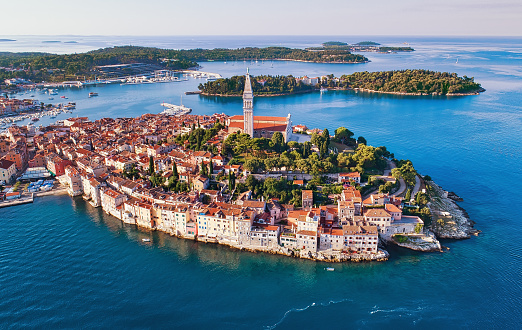
The Restaurant Scene
We noticed that the restaurant we had booked was large and elegant but empty. On the other hand, Scuba, La Puntulina, and the others on Natalina’s list were smaller and filled with diners, many of whom appeared to be locals enjoying their meals and having an uproarious time.
Frane was not scheduled to meet us for another half hour, so Chris thought he’d check with each of Natalina’s recommended restaurants to see if we could get the three of us in last minute. It was getting cold, so I sat on a bench and watched people stroll by, many with their dogs. I couldn’t brave one more cobblestone.
A Night Out at Scuba
Chris struck out with all the restaurants. But then Frane arrived and spoke with the head waiter at Scuba. There was much back and forth in Croatian, but he got us in. After that, all we had to do was wait until one of the locals finished his nightly grappa.
Forty minutes later, we were seated at a corner table inside the small, lively restaurant. The servers expertly maneuvered around the tightly-packed tables, carrying platters of seafood risotto, pasta, whole fish and octopus, squid tentacles, grilled steak, and fries, and most everything sprinkled with truffles.
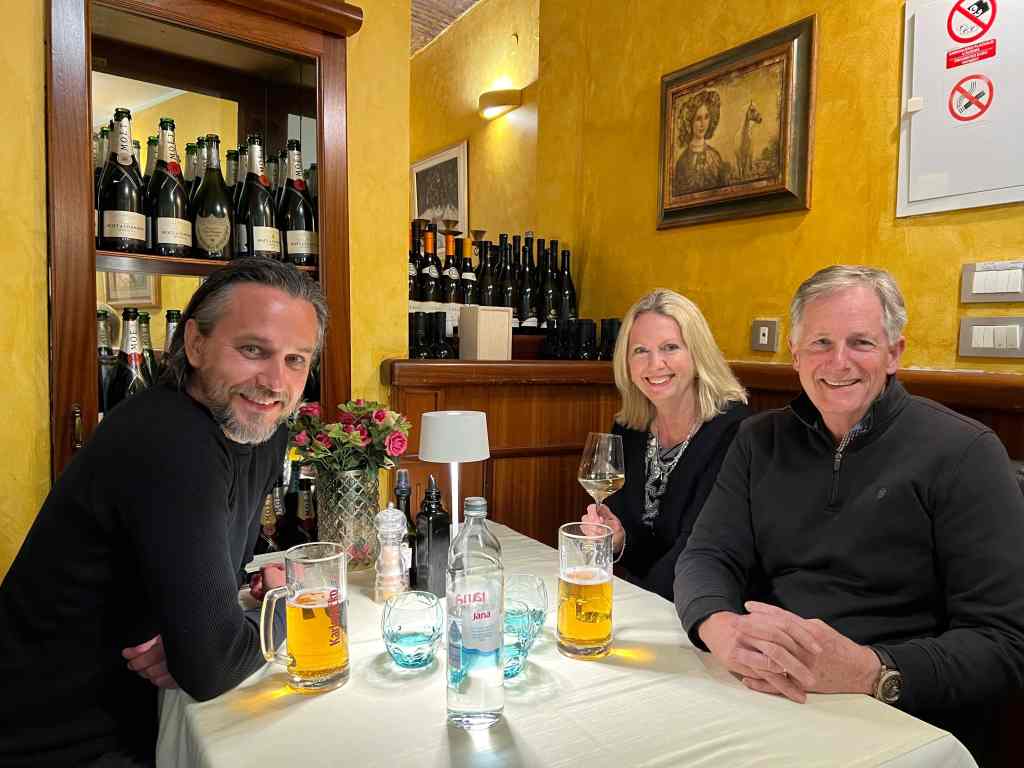
Chris and Frane drank beers, the drink of choice in Croatia, while I opted for a buttery Chardonnay. Our drinks paired well with the creamy risottos Chris and I had and Frane’s fillet steak and fries. All were generously dusted with truffles, and all were delicious.
Then the grappas appeared, and we soon lost track of time. Resourceful Frane scored cigarettes from one of the servers. To my surprise, even Chris, who had kicked the habit two decades ago, joined him. A philosophical discussion ensued under a cloud of smoke. I can’t recall the details nor how we managed to save the world that night, but we had a good time.
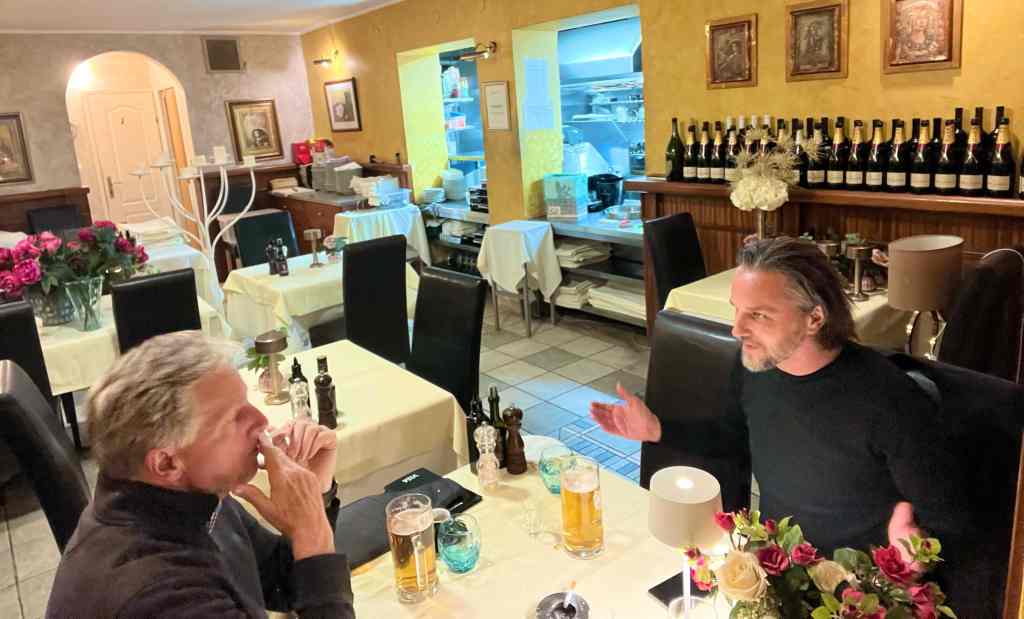
It was well past midnight when we finally realized we were the only diners, and the servers and kitchen staff were patiently waiting. We left a generous tip and said our goodbyes.
As we walked in the chilly night towards the outskirts of town, there wasn’t another soul in sight. But by some stroke of luck, we managed to call a cab to take us to our hotels. It was a memorable evening, and we remain indebted to Scuba for taking us in that night. I have a feeling they regretted that decision.
This article is the 7th in my 19-part Balkan series, which began with ‘Road Tripping on the Balkan Peninsula’ in September 2023. There, you will find our itinerary to help you plan your trip.
- Ratings are based on 1) Natural Beauty 2) Unique Activities 3) Old World Charm

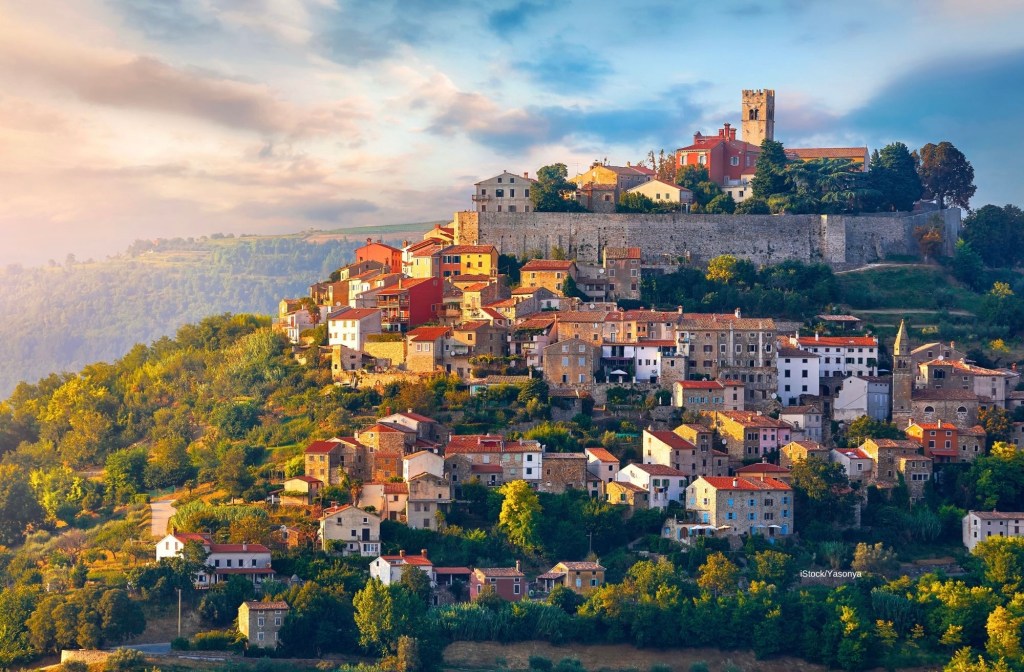
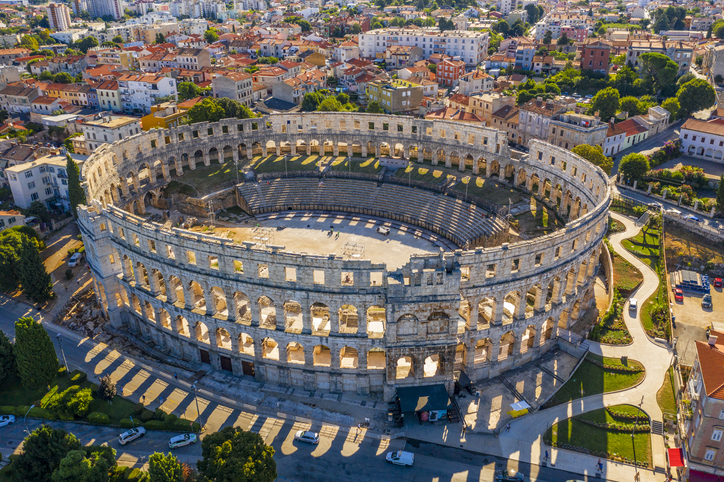










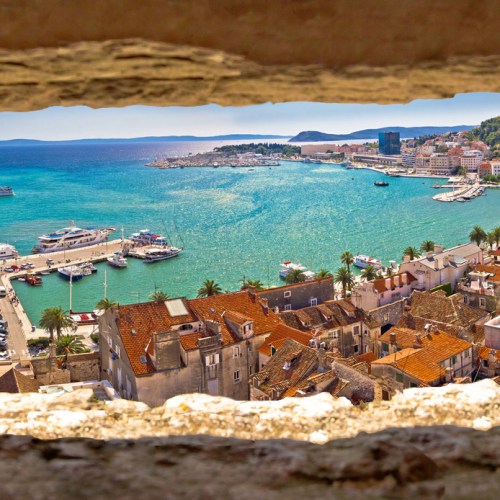
No comment yet, add your voice below!
Discover more from Travel The Four Corners
Subscribe now to keep reading and get access to the full archive.
Continue reading